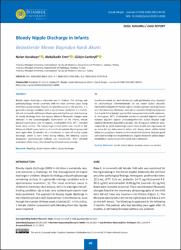| dc.contributor.author | Karabayır, Nalan | |
| dc.contributor.author | Eren, Abdulkadir | |
| dc.contributor.author | Canbeyli, Gülçin | |
| dc.date.accessioned | 2021-02-01T08:00:31Z | |
| dc.date.available | 2021-02-01T08:00:31Z | |
| dc.date.issued | 2020 | en_US |
| dc.identifier.citation | Karabayır, N., Eren, A. ve Canbeyli, G. (2020). Bloody nipple discharge in infants. Journal of Child, 20(1), 40-42. https://doi.org/10.26650/jchild.2020.1.0008 | en_US |
| dc.identifier.issn | 1302-9940 | |
| dc.identifier.issn | 1308-8491 | |
| dc.identifier.uri | https://doi.org/10.26650/jchild.2020.1.0008 | |
| dc.identifier.uri | https://hdl.handle.net/20.500.12511/6461 | |
| dc.description.abstract | Bloody nipple discharge is extremely rare in children. The etiology and pathophysiology remain uncertain, with the most common cause being mammary ductal ectasia. Despite its stressful course to the parents, it is generally a benign condition with a spontaneous resolution. A 3-monthold and a 6-month-old female infants were admitted to our clinic because of bloody discharge from the nipples. Bilateral fibrocystic changes were detected in the ultrasonographic examination of the infants, whose physical examination and hemogram, prothrombin time, aPTT, estradiol levels were normal. The hemorrhage ended within one month in the follow-up of both cases, but in our 6-month-old patient, bleeding recurred once again after 10 months. As a conclusion, in cases of bloody nipple discharge, which is seen rarely during infancy, the bleeding usually disappears spontaneously without any intervention. After detailed evaluation of the cases, they should be followed conservatively. | en_US |
| dc.description.abstract | Çocuklarda meme ucu kanlı akıntısı çok nadir görülmekte olup, etyolojisi ve patofizyolojisi bilinmemektedir. En sık neden duktal ektazidir. Ebeveynleri endişelendirmesine rağmen sıklıkla spontan olarak gerileyen selim bir durumdur. Memeden kanlı akıntı nedeniyle kliniğimize başvuran 3 ve 6 aylık iki kız bebeğin yapılan fizik muayenelerinde özellik saptanmadı. Hemogram, aPTT, prothrombin zamanı ve estradiol değerleri normal bulunan olguların yapılan ultrasonografilerinde duktal ektaziye bağlı bilateral fibrokistik değişiklikler görüldü. Her iki olgunun takibinde kanamaların bir ay içinde kaybolduğu saptanırken, 6 aylık olan olgumuzda 10 ay sonra bir kez daha kanama tekrar etti. Sonuç olarak sıklıkla duktal ektazi sonucu gelişen meme ucu kanlı akıntısında kanama, tedaviye gerek kalmadan kendiliğinden kaybolmaktadır. Olgular detaylı bir şekilde değerlendirildikten sonra konservatif olarak takip edilmelidir. | en_US |
| dc.language.iso | eng | en_US |
| dc.publisher | Istanbul University Press | en_US |
| dc.rights | info:eu-repo/semantics/openAccess | en_US |
| dc.rights | Attribution-NonCommercial 4.0 International | * |
| dc.rights.uri | https://creativecommons.org/licenses/by-nc/4.0/ | * |
| dc.subject | Bleeding | en_US |
| dc.subject | Ductal Ectasia | en_US |
| dc.subject | Infant | en_US |
| dc.subject | Nipple Discharge | en_US |
| dc.subject | Çocuk | en_US |
| dc.subject | Duktal Ektazi | en_US |
| dc.subject | Kanama | en_US |
| dc.subject | Meme Ucu Akıntısı | en_US |
| dc.title | Bloody nipple discharge in infants | en_US |
| dc.title.alternative | Bebeklerde meme başından kanlı akıntı | en_US |
| dc.type | other | en_US |
| dc.relation.ispartof | Journal of Child | en_US |
| dc.department | İstanbul Medipol Üniversitesi, Tıp Fakültesi, Dahili Tıp Bilimleri Bölümü, Çocuk Sağlığı ve Hastalıkları Ana Bilim Dalı | en_US |
| dc.department | İstanbul Medipol Üniversitesi, Tıp Fakültesi, Dahili Tıp Bilimleri Bölümü, Radyoloji Ana Bilim Dalı | en_US |
| dc.authorid | 0000-0002-8003-1952 | en_US |
| dc.authorid | 0000-0003-0958-6581 | en_US |
| dc.authorid | 0000-0003-2070-7014 | en_US |
| dc.identifier.volume | 20 | en_US |
| dc.identifier.issue | 1 | en_US |
| dc.identifier.startpage | 40 | en_US |
| dc.identifier.endpage | 42 | en_US |
| dc.relation.publicationcategory | Diğer | en_US |
| dc.identifier.doi | 10.26650/jchild.2020.1.0008 | en_US |



















